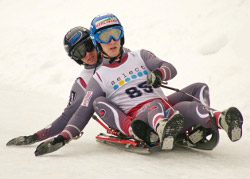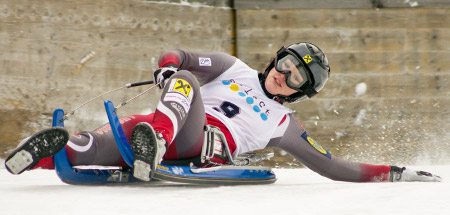Lesson: The Luge
 (Lesson plan courtesy of Discovery Education)
(Lesson plan courtesy of Discovery Education)
Grade Level: 3-8
Time Needed: 1 or 2 class periods
Overview
Students build a simulated luge track and make predictions about the impact on speed of surface type, shape of the luge, wind resistance, and angle of the slope of their track. They test their predictions by conducting several simulated luge runs and draw conclusions about the effects of physical forces on the sport of luging.
Standards
This lesson plan addresses the following standards from the National Science Education Standards:
Grades K-4
• Unifying Concepts and Processes: Evidence, models, and explanation
• Unifying Concepts and Processes: Change, constancy, and measurement
• Science as Inquiry: Abilities necessary to do scientific inquiry
• Science as Inquiry: Understandings about scientific inquiry
• Physical Science: Properties of objects and materials
• Physical Science: Position and motion of object
Grades 5-8
• Unifying Concepts and Processes: Evidence, models, and explanation
• Unifying Concepts and Processes: Change, constancy, and measurement
• Science as Inquiry: Abilities necessary to do scientific inquiry
• Science as Inquiry: Understandings about scientific inquiry
• Physical Science: Properties and changes of properties in matter
• Physical Science: Motions and Forces
• Physical Science: Position and motion of object
Materials
Cardboard strips
Tape
Small fans
Aluminum foil
Wax paper
Oil
Butter
Stopwatches
Quarters
Popsicle sticks
Opening Procedure
Begin the lesson by reviewing the definition of a force. Explain that gravity is a force that pulls two objects toward each other. Give an example, such as throwing a snowball up in the air. Ask students to name other examples of gravity in fun activities. (Possible answers include a roller coaster, a skydiver, a bungee jumper, etc.) Explain that friction is a force that pulls when two objects touch each other. Give a relevant example. Ask if students can think of examples of friction. (Possible answers include wind resistance in skydiving, tires against the road, chalk on a pole-vaulter’s hands against the pole, etc.) Ask students if they think friction increases or decreases acceleration.
Introduce the lab by asking students if they know about the Winter Olympics sport called luge.
 Background information: The word luge (pronounced LOOZH) is French for “racing sled.” Luge has its roots in the 16th century, but it didn’t become an Olympic sport until 1964. The luge sled usually has two wooden runners connected by two steel bridges with a seat slung between. The surface of each runner is plastic or steel. At the start gate, competitors grasp handles, that help them launch the sled down the ice. Racers “paddle” along the ice to increase their momentum for about ten feet. They use gloves with small spikes in the fingertips for better grip. Once underway, racers travel down the course lying on their backs feet first; they have limited vision. They go through 17 curves on 4,318 feet of track in less than one minute, sometimes traveling 90 miles an hour. A luge has no brakes. Athletes steer by applying pressure against the sides of the luge with their feet, shoulders, and legs. They stop the sled by sitting up and putting their feet on the ice. The Olympic luge events include singles (one racer) and doubles (two racers). In singles luge, a racer takes four runs down the track. The four times are added together for a total time. The winner is the one who achieves the fastest total time. In doubles luge, pairs take two runs; the winners have the fastest time.
Background information: The word luge (pronounced LOOZH) is French for “racing sled.” Luge has its roots in the 16th century, but it didn’t become an Olympic sport until 1964. The luge sled usually has two wooden runners connected by two steel bridges with a seat slung between. The surface of each runner is plastic or steel. At the start gate, competitors grasp handles, that help them launch the sled down the ice. Racers “paddle” along the ice to increase their momentum for about ten feet. They use gloves with small spikes in the fingertips for better grip. Once underway, racers travel down the course lying on their backs feet first; they have limited vision. They go through 17 curves on 4,318 feet of track in less than one minute, sometimes traveling 90 miles an hour. A luge has no brakes. Athletes steer by applying pressure against the sides of the luge with their feet, shoulders, and legs. They stop the sled by sitting up and putting their feet on the ice. The Olympic luge events include singles (one racer) and doubles (two racers). In singles luge, a racer takes four runs down the track. The four times are added together for a total time. The winner is the one who achieves the fastest total time. In doubles luge, pairs take two runs; the winners have the fastest time.
If possible, have students watch a demonstration of luge skills and a run at this website. After viewing the video and learning about the sport from the site, have students brainstorm the forces that affect a luge run. What forces can cause a luge to gain speed? What forces can cause its speed to decrease?
Tell students that they will learn more about the effect of forces by building their own luge track–one that is covered with various materials, instead of ice. They will make predictions about the speed that can be achieved on each surface, then conduct a lab to test their predictions. During the lab, two different objects will careen down the cardboard slope, each time covered by a different type of surface, and under different circumstances.
Before the lab, have students make predictions. Review the kinds of surfaces below. Have them predict the order of these track surfaces, from fastest (1) to slowest (10). (You also may substitute other types of surface materials.)
Aluminum foil ___
Aluminum foil with butter ___
Aluminum foil with water ___
Aluminum foil with crushed ice ___
Aluminum foil with oil ___
Wax paper ___
Wax paper with butter ___
Wax paper with water ___
Wax paper with crushed ice ___
Wax paper with oil ___
Which object would go faster down any of the tracks listed above: a quarter or a Popsicle stick?
Would the object go faster, slower, or at the same rate of speed on a slope with a 30-degree angle or a 60-degree angle?
Would an object with wind blowing up the ramp go faster or slower than an object with no wind resistance?
Main Procedure
Divide the class into groups. Give each group a strip of cardboard to use as their simulated track. Have each group choose a surface from the list above to cover their cardboard. As a class, come up with ways to keep all of the other variables the same on the track. Once the tracks are covered, have each group prop theirs up at a 60-degree angle.
Give each group two objects to simulate the luge: a Popsicle stick and a quarter.

Have each group select a person to use a stopwatch to time each run. Have the groups place their quarter flat at the top of their ramp. One or two students should use a ruler to hold the quarter in place at the starting line. At your command, they will lift the ruler quickly–like raising a gate. As in the Olympics singles event, each group will make four runs: two with the quarter and two with the Popsicle stick. Add the times together for all four runs. Which track demonstrated the fastest luge? Which object had the fastest time? How do these results compare to student predictions?
Next, have students test the effect of wind resistance on their tracks. Using the same track surface, students will conduct another set of four runs with a small fan blowing up the ramp. Does the speed of the run increase, decrease, or stay the same? What conclusions can they make about wind resistance?
Finally, have students make another set of runs on a slope with a 30-degree angle. Does the speed of the run increase, decrease, or stay the same? How does this compare to student predictions?
Students should combine all their information to make conclusions about the effect of physical forces on the sport of luging.
Vocabulary
acceleration – the rate of change of velocity with respect to time
• context: The acceleration of the luge increased as the ice melted.
aerodynamic – designed to reduce wind drag and improve efficiency or acceleration
• context: Luge racers often wear skintight, aerodynamic suits.
deceleration – to decrease the velocity of
• context: Racers can cause deceleration when they sit up in their luge.
friction – the force that pulls or resists the motion of two objects or materials that are in contact with each other
• context: As the ice surface melts, the friction between the luge and the ice is reduced.
gravity – the force that pulls two objects toward each other
• context: Gravity is the force that causes the luge to ride downward.
velocity – the rate at which an object changes its position
• context: The velocity of the luge changes dramatically as it goes through the “s” curve of the track.
Evaluation
Use the following three-point rubric to evaluate students’ work during this lesson.
Three points: Students made predictions based on sound reasoning, performed experiments carefully, recorded their results accurately and completely, made clear and logical explanations, and worked cooperatively in groups.
Two points: Students made predictions based on sound reasoning, performed experiments with sufficient care, recorded their results incompletely, made acceptable explanations, and worked somewhat cooperatively in groups.
One point: Students made predictions based on guesswork, performed experiments with sufficient care; recorded their results incompletely or inaccurately, made confusing explanations, and had trouble working in groups.
Credits
Robin Porter, freelance education writer, with contributions from Andrea Geyer, secondary physics teacher, Chesapeake, Virginia
“Christian and Andreas Schopf Austrian Luge Championships 2010” and “Melanie Batkowski Austrian Luge Natural Track Championships 2010” by Christian Jansky (Wikipedia Commons)
“Luge Pictogram” by Parutakupiu (Wikipedia Commons)
Filed under: Class Activities, Grades 6-8, Grades 6-8, Grades K-5, Grades K-5, Lesson Plans
Tags: Class Activities, Curriculum, Grades 3-8, Lesson Plan, Lesson Plans, Teacher Resources








